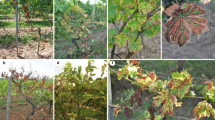Abstract
The effects of two training systems and row spacing on development of powdery mildew caused by Uncinula necator on clusters of 'Chardonnay' and 'Cabernet Sauvignon' grapevines were examined. Disease development was monitored in blocks with two different row spacing (2 and 3 m) in vertical shoot positioned vines (VSP) and in free-positioned, topped vines (FC) with no foliage support wires. The FC vines were hedged to about one meter shoot length. No fungicides were applied and disease powdery mildew level was recorded four to seven days after appearance of the first disease symptoms. During five consecutive years (1994–1998), disease incidence was higher in the VSP system than the FC vines. The difference was high when disease level was low (30% of the clusters in VSP vines infected, compared to 5% in the FC vines) and decreased when disease pressure was high (79% in VSP compared to 46% in FC vines). In the 'Cabernet Sauvignon', in four of the years, disease incidence was higher in the narrow spacing of 2 m between the rows than that in the wider 3 m spacing. Microclimate (temperature, relative humidity and light intensity) was monitored in the cluster zone near the spurs of 'Chardonnay' vines during three weeks in the 1998 season. In VSP vines light intensity was lower then that in FC vines both four and one week before disease symptoms appeared (72% and 18% respectively). The differences in temperature and relative humidity were less than 1°C and 3%, respectively, and most likely did not affect disease development. The results suggested that high light intensity is the primary factor, which limits powdery mildew growth development on field-grown grapevines in the Golan region of Israel. The use of the FC system might be useful in reducing the need of fungicides.
Similar content being viewed by others
References
Bulit J and Lafon R (1978) Powdery mildew of the vine. In: Spencer DM (ed) The Powdery Mildew (pp 525-548) Academic Press, New York
Chellemi DO and Marois JJ (1992) Influence of leaf removal, fungicide applications, and fruit maturity on incidence and severity of grape powdery mildew. American Journal of Enology and Viticulture 43: 53-57
Cortesi P, Gadouri DM, Seems RC and Pearson RC (1995) Distribution and retention of cleistothecia of Uncinula necator on the bark of grapevines. Plant Disease 79: 15-19
Dekker J (1987) Build-up and persistence of fungicide resistance. In: Brent EJ and Atkin EK (eds) Rational Pesticide Use. (pp 153-168) Cambridge University Press, Cambridge, UK
Delp CJ (1954) Effect of temperature and humidity on the grape powdery mildew fungus. Phytopathology 44: 615-626
English LT, Thomas CS, Maroi JJ and Gubler WD (1989) Microclimates of grapevine canopies associated with leaf removal and control of Botrytis bunch rot. Phytopathology 79: 395-401
Kliewer MW, Marois JJ, Bledsoe AM, Smith SP, Benz MJ and Silverstoni O (1988) Relative effectiveness of leaf removal, shoot positioning, and trellising for improving wine grape composition. In: Smart R, Thornton R, Rodrigez S and Young J (eds) Proceedings of the Second International Cool Climate Viticulture and Oenology Symposium (pp 123-126) Auckland, New Zealand
Lavee S, Zahavi T and Naor A (1993) A study on density and training for a fully mechanized vineyard of cvs. Chardonnay and Cabernet Sauvignon. Acta Horticulturae 349: 49-53
Ougeh CS and Berg HW (1979) Powdery mildew sensory effect on wine. American Journal of Enology and Viticulture 30: 321
Pearson RC (1988) Powdery mildew. In: Pearson RC and Goheen AC (eds) Compendium of Grape Diseases (pp 9-11) APS Press, St. Paul, MN, USA
Pscheidt JW and Pearson RC (1989) Effect of grapevine training systems and pruning practices on occurrence of Phomopsis cane and leaf spot. Plant Disease 73: 825-828
Reuveni M and Reuveni R (1995) Efficacy of foliar sprays of phosphates in controlling powdery mildews in field-grown nectarine, mango trees and grapevines. Crop Protection 14: 311-314
Rotem J, Wooding B and Aylor DE (1985) The role of solar radiation, especially ultraviolet, in the mortality of fungal spores. Phytopathology 75: 510-514
Steva H and Clerjeau M (1990) Cross resistance to sterol biosynthesis inhibitor fungicides in strains of Uncinula necator isolated in France and Portugal. Meded Fac Landbouwwet Rijksuniv Gent 55: 983-988
Stevenson RE and Pennypacker SP (1988) Effect of radiation, temperature, and moisture on conidial germination of Alternaria solani. Phytopathology 78: 926-930
Willocquet L, Colomber D, Rougier M, Fargus J and Clerjeau M (1996) Effects of radiation, especially ultraviolet B, on conidial germination and mycelial growth of grape powdery mildew. European Journal of Plant Pathology 102: 441-449
Ypema HL, Ypema M and Gubler WD (1997) Sensitivity of Uncinula necator to benomyl, triadimefon, myclobutanil, and fenarimol in California. Plant Disease 81: 293-297
Author information
Authors and Affiliations
Corresponding author
Rights and permissions
About this article
Cite this article
Zahavi, T., Reuveni, M., Scheglov, D. et al. Effect of Grapevine Training Systems on Development of Powdery Mildew. European Journal of Plant Pathology 107, 495–501 (2001). https://doi.org/10.1023/A:1011289018599
Issue Date:
DOI: https://doi.org/10.1023/A:1011289018599




